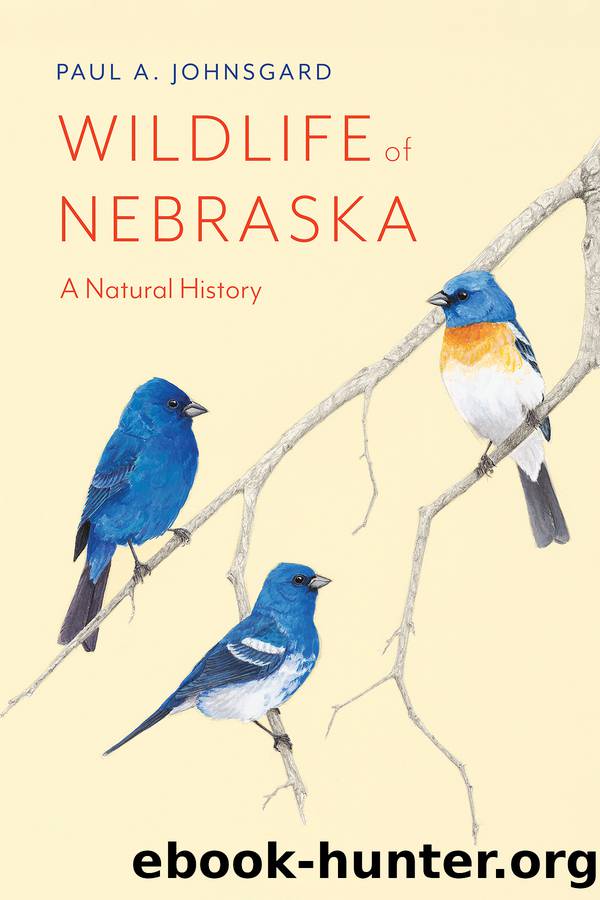Wildlife of Nebraska by Paul A. Johnsgard

Author:Paul A. Johnsgard [Johnsgard, Paul A.]
Language: eng
Format: epub
Tags: NAT001000 Nature / Animals / General, NAT045020 Nature / Ecosystems & Habitats / Plains & Prairies
Publisher: University of Nebraska Press
Peregrine Falcon. Falco peregrinus
Status: Extirpated in the wild but locally reestablished in Omaha and Lincoln directly or indirectly through rearing and release programs (hacking) of young birds (Johnsgard 2010b). National Breeding Bird Surveys from 1966 to 2015 indicate that this speciesâ population underwent a survey-wide average annual increase of 2.77 percent (Sauer et al. 2017). This species is on the Nebraska Natural Legacy Projectâs Tier 2 list of threatened species in Nebraska (Schneider et al. 2018).
Habitats and Ecology: This species is largely a cliff-nesting species but has adapted to city-nesting on very tall buildings (usually at least 11 stories high). Nonbreeders occur over a wide habitat range, from mountain meadows to grasslands, marshes, and riparian habitats.
Breeding Biology: After a pair has returned to its nesting area, the male or both birds perform courtship flights consisting of diving and swooping and sometimes passing food in the air. Mating is frequent during this period and the period of egg-laying, with the eggs laid at intervals of about two or three days. The clutch size is usually three or four eggs, and the incubation period lasts 28â29 days. The female does most of the incubation, with the male bringing prey to his mate and also occasionally relieving her. The female typically eats away from the nest on a nearby âplucking post.â For the first two weeks after hatching, the female does nearly all the brooding and feeding of the young, but later both adults hunt extensively and simply drop their prey into the nest, letting the young birds compete for it and tear it up. Usually only two or three young fledge from each brood; fledging occurs about 35â42 days after hatching. With the advent of modern pesticides and before they were outlawed, virtually no young were fledged at most nests, since the thin-shelled eggs laid by pesticide-poisoned females failed to hatch, or else the young did not survive to fledging.
Download
This site does not store any files on its server. We only index and link to content provided by other sites. Please contact the content providers to delete copyright contents if any and email us, we'll remove relevant links or contents immediately.
The Lonely City by Olivia Laing(4746)
Animal Frequency by Melissa Alvarez(4394)
All Creatures Great and Small by James Herriot(4230)
Walking by Henry David Thoreau(3892)
Exit West by Mohsin Hamid(3776)
Origin Story: A Big History of Everything by David Christian(3648)
COSMOS by Carl Sagan(3553)
How to Read Water: Clues and Patterns from Puddles to the Sea (Natural Navigation) by Tristan Gooley(3406)
Hedgerow by John Wright(3274)
The Inner Life of Animals by Peter Wohlleben(3259)
How to Read Nature by Tristan Gooley(3249)
How to Do Nothing by Jenny Odell(3232)
Project Animal Farm: An Accidental Journey into the Secret World of Farming and the Truth About Our Food by Sonia Faruqi(3176)
Origin Story by David Christian(3145)
Water by Ian Miller(3126)
A Forest Journey by John Perlin(3026)
The Plant Messiah by Carlos Magdalena(2881)
A Wilder Time by William E. Glassley(2818)
Forests: A Very Short Introduction by Jaboury Ghazoul(2790)
